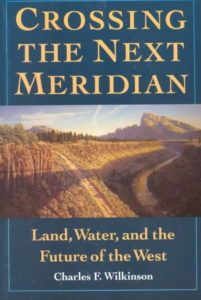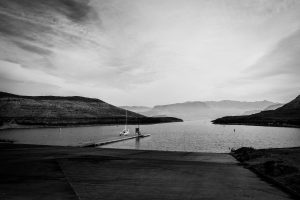tl;dr: MY BOOK IS COMING OUT IN PAPERBACK IN MARCH YOU SHOULD BUY COPIES FOR ALL YOUR FRIENDS IT WILL FIT MORE EASILY IN YOUR BAG FOR PLANE FLIGHTS I STILL HAVE SHARPIES AND WILL SIGN IT FOR YOU WHEN WE NEXT MEET
longer: Writing a new “afterward” for the paperback edition of Water is For Fighting Over and Other Myths About Water in the West (DID I MENTION IT’S COMING OUT IN MARCH!!!!), I’ve been spending a bunch of time reflecting on the last couple of years. Writing a book bears a more than passing similarity to parenthood. You do your utmost to prepare your offspring. You send them out into the world carrying your best intentions, and then they life a life of their own, forever connected to you yet beyond your power to do much to influence their trajectory.
In the winter of 2015, as I was completing the manuscript of Water is For Fighting Over, I was optimistic about our ability to solve the Colorado River’s problems, and I said so, in a very public way.
In the rhetoric of the basin, with declining reservoirs and enduring water allocation struggles, optimism seemed odd. Every time there was news of a new water allocation struggle, I’d get the questions: “Still optimistic, Fleck?” “Turns out water is for fighting over after all” became my standard self-deprecating joke.
I tried to make a point in the book, which in retrospect I didn’t make clearly enough, that the collaboration/negotiation/compromise framework I advocate is not without conflict.
At the scale of the entire Colorado River Basin, in the messy complex of governance that manages decisions about who gets how much of the big river’s water, we have made tremendous progress. Governments have banded together to come up with a plan to reduce California’s overuse of the river, and they’ve developed a deal with Mexico to share surpluses and shortages, and even to spare some precious water to return flows to the Colorado’s parched channel through its old Mexican delta. This was rarely easy, but it resulted in deals that benefited a spectrum of water users and community values.
Underlying both of these models of success is a willingness to recognize water problems and collaborate in solving them, often across geographic, political, and organizational boundaries. Conflict is sometimes a part of these processes, but ultimately success comes by avoiding fights over water.
But these successes have not been enough, something that can be seen most clearly in Lake Mead itself, the first great reservoir that stores the Colorado River’s water for millions of people downstream. Despite the hope offered by the success stories described above, we have not done enough. Lake Mead continues to shrink. Water users continue to take more out of the Colorado River system than nature puts in, keeping us on an unsustainable path. (emphasis added)
Arizona’s current struggles to come up with a plan to reduce its Colorado River water use is a tremendous challenge to my optimism, the latest and most bitter subject of my “water’s for fighting over after all” jokes.
But if you look closely at the lingering obstacles standing in the way of progress in the Colorado River Basin, Arizona is only the most noticeable example of a common type of problem – the last gasp of an old way of thinking about this river system we all love.
My optimism comes from the fact that this old way of thinking is dying.
 The great Charles Wilkinson, in his book Crossing the Next Meridian, called them “the lords of yesterday”, an outdated set of resource extraction ideas stubbornly resistant to our new realities. The “lords” are embedded in outdated laws that allocated more water than the river has, and in outdated expectations by communities around the basin that the water promised by those laws will someday trickle through their irrigation headgates or flow from their taps.
The great Charles Wilkinson, in his book Crossing the Next Meridian, called them “the lords of yesterday”, an outdated set of resource extraction ideas stubbornly resistant to our new realities. The “lords” are embedded in outdated laws that allocated more water than the river has, and in outdated expectations by communities around the basin that the water promised by those laws will someday trickle through their irrigation headgates or flow from their taps.
At the scale of the Colorado River Basin, we have largely abandoned the lords, in long and difficult revisions to the old “Law of the River” rules that, if we can actually figure out how to implement them, will bring the basin’s water use more closely into line with hydrologic reality.
But we continue to face a problem I talked about in Water is For Fighting Over – importantly, in the book’s chapter about Arizona:
Within the network of state and water-agency representatives working on Colorado River Basin problems, there is a clear recognition that eventually some sort of “grand bargain” will be needed that finds a way to reduce everyone’s water allocation. To keep the system from crashing, everyone will have to give something up. But each of the participants in that core network also understands the dilemma that follows: each must then go home and sell the deal in a domestic political environment that views the river’s paper water allocations as a God-given right.
Arizona’s belligerence in the summer of 2015 was a stark reminder of the way domestic in-state politics stands in the way of real solutions to the basin’s problems. Without a change in attitude, Arizona’s belief that “water’s for fightin’ over” could become, rather than a myth, a self-fulfilling prophecy.
As the next piece of the “grand bargain”, the ill-named “Drought Contingency Plan”, inches toward completion, it is again Arizona that stands in the way. Farmers in Pinal County, staggeringly uneconomical absent massive subsidies to pump Colorado River water their way, are engaged in a bitter “lords of yesterday” fight to expand their subsidies and thwart Arizona’s best efforts to come to terms with a declining Colorado River water supply.
The remaining points of friction share the “lords of yesterday” thinking, what Eric Kuhn calls “keeping the dream alive” – a pipeline to St. George, the expansion of a dam in Wyoming, or the quiet belief that one more Colorado trans-basin diversion might yet be possible.
These represent genuine conflicts. But as I write a new “afterward” to Water is For Fighting Over, I remain optimistic. These are not fundamental challenges to the new use-less-water order we are trying to build. They are instead last gasps of an old way of thinking.


I still believe that water is for cooperating over, just because the win-lose, zero-sum game isn’t really available to solve conflicts such as the CAP Curtailment. Your new edition of “Fighting” seems to offer a more realistic assessment. I do wonder whether any of your water development colleagues think we share a hydrologic commons. I still recall a fellow over on the San Juan who told me “the public interest doesn’t exist”. Really!
I haven’t read your book, but if not mentioned you should point out the efforts people in other countries have made in water conservation that for the most part, at least to my limited knowledge are not being made in the southwest. As an example, my father-in-law adopted drip irrigation 20 to 25 years ago in Callosa d’en Sarria in Alicante province in Spain. He was one of the first, but now everyone in his community that grows loquats has adopted this method. I know the Israelis have used cement lined irrigation ditches since the 1960s, but I know that many if not most irrigation ditches in NM are not. Finally, in areas where there is not enough water for municipal supply, new homes should be required to include water harvesting systems for water destined for sewer and all grey water use. I tried to push these ideas for years to no avail. Rio Rancho, for example had water supply problems, yet they do not subsidize water harvesting. Unfortunately, Republicans and conservatives do not want to adopt any scientific changes to make the system more efficient and prefer to hire lawyers and win in court battles. As a final remark, I rent my solar home in Rio Rancho, which you have been out to visit, to small families. It has only no city water or well, only harvested water. I now have about a 6500 gallon storage capacity, somewhat larger than when you visited. The last family did not have to buy water for three years until last spring when we had a severe drought.
Recent articles have concentrated on the Drought Contingency Plan with good reason. These negotiations have opened old wounds as you have aptly addressed. When describing the the problem I often liken our situation to a game of musical chairs with the chairs represnting the Colorado River water as a resource and those circulating the chairs as representative of the 40 Million people relying on Colorado River water. Climate change is taking chairs out of the game while more people are being added to those circulating the remaining chairs. Even though these people may be talking now, each one of them is eyeing a chair they can take as their own when the music stops. We all know at some point the music will stop, but there does not appear that the consensus is to make room on the chairs so everyone will get a seat. I do not share your optimism.
Back in the day, Tempe, AZ abutted the dry bed of the Salt River. Streets connecting to Scottsdale and Phoenix ran through that riverbed; there was only one narrow bridge connecting Tempe and Phoenix. Very occasionally water would briefly appear in the river, and that bridge was a choke point for traffic. There were, however, two “100-year” floods in consecutive years.
Now, Tempe has a large artificial lake where the riverbed used to be, full of water year-round. Arizona State University even has competitive rowing teams! Whenever I look at that I shake my head in disbelief. It is the most visible symbol of Arizona’s intransigence in dealing with water realistically.